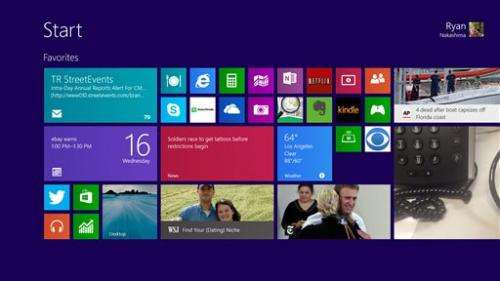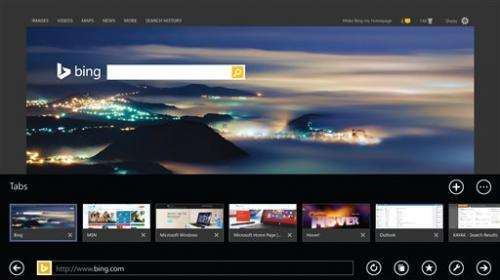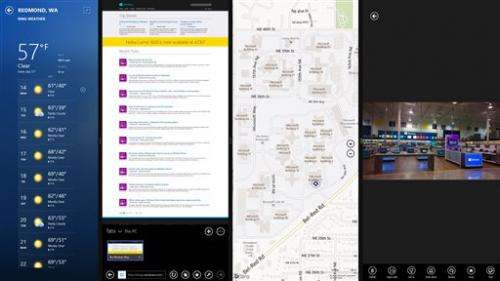Microsoft releasing Windows 8.1, a year in making

Microsoft is releasing its long-awaited Windows 8.1 upgrade as a free download starting Thursday. It addresses some of the gripes people have had with Windows 8, the dramatically different operating system that attempts to bridge the divide between tablets and PCs.
Windows 8.1 still features the dual worlds that Windows 8 created when it came out last October. On one hand, it features a touch-enabled tile interface resembling what's found in tablet computers. On the other, there's the old desktop mode where the keyboard and mouse still reign. The update adds some new finger- and gesture-friendly shortcuts for touch-based apps, while restoring some respect for the desktop mode that a billion PC users have become accustomed to.
The release comes as sales of traditional desktop and laptop computers continue to decline because consumers are spending money instead on the latest smartphones and tablets. It also comes at a time of transition for Microsoft as the Redmond, Washington, company focuses on devices and services, not just software. Earlier this month, Microsoft struck a deal to acquire Nokia's phone business and patent rights for more than $7 billion. Microsoft is also searching for a new CEO to replace Steven A. Ballmer, who announced last month that he plans to retire within the next year.
The Window 8.1 update is free for current owners of Windows 8. It's available starting at 7 a.m. (1100 GMT) Thursday in New York, which corresponds to the start of Friday in New Zealand. Simply go to the Windows Store app to find it. It may take a few hours for updates to reach everyone. Computers with Windows 8.1 already installed will go on sale Friday local time. That's also when people will be able to buy stand-alone copies of Windows 8.1.
The changes range from the cosmetic to improved functionality:
RESTORING RESPECT FOR THE DESKTOP
START ME UP—The Start button is back in desktop mode, although not the way it was before Windows 8 came along. In Windows 7 and before, a click on Start would have brought up programs and important folders in a list. Now, one tap on Start flips you back to the new tile interface, where you can click or tap tiles to open programs. A long press brings up crucial settings such as the Control Panel.
BOOT TO DESKTOP—You can now start up the machine in desktop mode, bypassing the tiles for a short time. That removes some of the headache for companies that want to use Windows 8 but don't want to buy a touch-screen monitor for every employee.

TOUCH AND GESTURE UPDATES
ONSCREEN KEYBOARD SWIPES—The onscreen keyboard now includes the ability to type numbers or punctuation marks by swiping up or away from certain keys on the standard "QWERTY" layout, eliminating the need to toggle between numeric and alphabetic layouts. You can also select from suggested words mid-stream using side swipes and taps on the virtual spacebar.
GESTURE-ENABLED APPS—You can now wave in the air in front of the front-facing camera to get a response. For example, in the new app Bing Food & Drink, a right-to-left wave in "Hands Free Mode" flips through pages of a recipe.
QUICKER TILE ORGANIZING—You can tap and hold Windows tiles with your finger to move them. Another couple taps will allow you to resize them in one of four sizes. In the previous version, you had to go back to the mouse or touchpad and right-click on tiles to do this, and you were limited to two sizes.
EASIER APPS ACCESS—Finding all your apps takes just a swipe up on your start screen, as long as you don't do it from beyond the bottom edge. Before, you had to swipe up from the bottom edge, then tap on the All Apps button.
SMALL CONVENIENCES
AUTOMATIC UPDATES—Apps update in the background, replacing the constant reminders to go to the Windows Store to update the apps yourself.
SMALLER TABLETS—Windows 8.1 now has a home screen that looks good in portrait mode on screens measuring 7 inches to 8 inches diagonally.
LOCK SCREEN ACCESS—You can now answer Skype calls or take photos from the lock screen without having to log in. Just swipe down. You can also set other apps like Twitter to send notifications when the screen is locked.

FUNCTIONAL CHANGES
BETTER MULTITASKING—In Windows 8.1, you can run up to four apps at once side by side, double the previous amount, though you need a large, high-resolution monitor to do so (On its own, Microsoft's Surface tablets are not big enough for more than two). You can resize panes using a slider that moves side to side, instead of being limited to one larger window and one slender one. This is still not as capable as Windows 7 or in desktop mode, where you can open dozens of items in windows that can be resized both horizontally and diagonally. And many app makers have yet to adapt, meaning some apps still appear as a thin sliver, even if you want them to take up half the screen.
GLOBAL SEARCH—Typing while on the tile-based start screen will pull up multiple search results—if applicable—from your computer, the Web and the Windows app store. If you're searching for a musician, you'll see a list of popular songs you can play using Xbox Music, and if it's someone famous (like President Barack Obama) you'll see biographical details, videos and other information. Before, you had to choose where to search: in apps, settings, computer file or on the Internet.
EMAIL UPDATE—The standard-issue Mail app now has a "power pane" on left-hand side with folders for updates from social networks like Facebook, messages from favorite contacts and newsletters. Some of these features work only with Microsoft accounts such as Hotmail and Outlook.com, though. A new "sweep" command deletes multiple messages with a couple taps.
BETTER BROWSING—No longer are you limited to 10 open tabs in the tile version of Internet Explorer. Before, Web pages automatically closed without prompts when you try to open more. You can open as many as you want now. Better yet, you can have two different websites displayed side by side, the way you've long been able to before Windows 8 came along.
FUN STUFF
XBOX MUSIC REFRESH—The music streaming app now optimizes playback over discovery with a layout that has more lists and smaller photos. It also adds the ability to create playlists from any website with a couple taps. When on a website featuring artists, swipe in from the right edge and tap the Share button followed by the Music button. It will create a song playlist based on those artists, which you can then stream for free.
PICTURE EDITING—A picture editor with pre-set effects comes with the update, allowing for photo touchups, cropping, contrast changes and other features.
XBOX ONE INTEGRATION—You can pick up where you left off if you start playing a video purchased on Xbox Video on a tablet and then watch the rest on Microsoft's upcoming game console, Xbox One.
Developments with Microsoft's new Windows 8 system
The launch of Windows 8 a year ago was heralded as the biggest change to the industry's dominant operating system in at least 17 years. It attempts to bridge the gap between personal computers and fast-growing tablets with its touch-enabled interface. But consumer reaction has been lackluster. An update addressing some of the feedback is due out on Thursday.
Here's a look at events surrounding Microsoft Corp.'s new system:
— Oct. 25, 2012: Microsoft holds a launch event in New York for Windows 8, a major overhaul of its ubiquitous computer operating system. Not much new is revealed, as many of the details had been announced before, and the software had been available for testing.
— Oct. 26: First day of sales for desktops, laptops and tablets with Windows 8, including Microsoft's Surface RT tablet running a lightweight version of Windows 8. Upgrades from older versions of Windows become available.
— Oct. 29: Microsoft launches phone version of new operating system, Windows Phone 8. Windows 8 phones begin shipping that week.
— Nov. 12: In a management shake-up, Microsoft says Steven Sinofsky, the president of its Windows and Windows Live operations, is leaving the company. The company does not give a reason. Company veteran Julie Larson-Green is promoted to lead all Windows software and hardware engineering. Tami Reller takes over responsibility for the Windows business.
— Nov. 13: Microsoft releases its redesigned browser, Internet Explorer 10, for computers running the older Windows 7 system. Although Microsoft designed Internet Explorer 10 with Windows 8's touch interface in mind, the Redmond, Wash., company wants people to see the browser's potential on their Windows 7 machines.
— Nov. 28: Microsoft says about 40 million licenses to Windows 8 were sold in its first month on the market, though that number includes licenses bought by PC manufacturers for machines built but not yet sold. Microsoft didn't provide further details beyond saying that Windows 8 is being embraced by a list of companies that include Johnson & Johnson, British Telecom and Bank of America Corp.
— Nov. 29: NPD Group says sales of personal computers in the U.S. didn't get any boost from the launch of Windows 8. There's no sign that Windows 8 made things worse for PC makers. Rather, NPD says the weak sales are a continuation of a trend seen throughout this year.
— Jan. 8, 2013: Microsoft says it has sold 60 million Windows 8 licenses to date.
— Jan. 29: Microsoft begins selling Office 2013, its first overhaul of the popular software suite in three years. This time, it is pushing sales through $100-a-year subscriptions, although it continues to offer the product as a single purchase. Despite Microsoft's efforts to get consumers to embrace a tablet-style interface in Windows 8, most of Office 2013 requires the older, desktop mode.
— Feb. 9: Microsoft begins selling Surface Pro, with a full version of Windows 8.
— April 10: Reports from research firms IDC and Gartner document double-digit sales decreases in PCs during the first three months of the year—the worst drop ever in the PC industry. IDC says Windows 8 seems to have hurt rather than helped PC sales.
— May 7: Microsoft says it will retool Windows 8 to address complaints and confusion, though it offers few details. Microsoft also discloses that it has sold more than 100 million Windows 8 licenses.
— May 14: Microsoft says its Windows update, previously codenamed Blue, will be called 8.1 and will be free to Windows 8 users.
— May 30: Microsoft details some of the changes. Users will be able to set their machines to start automatically in the older, desktop mode. A Start button is restored in look, though clicking on it will lead to Window 8's full-screen startup page rather than the Start menu found in older Windows.
— June 26: Microsoft releases a preview version on Windows 8.1 as it kicks off Build, a three-day conference in San Francisco for partners and other developers. Microsoft CEO Steve Ballmer acknowledges that the company pushed hard to get people to embrace a radical change. Microsoft is now back-pedaling, making it easier to reach and use the older desktop interface.
— July 10: Gartner and IDC say that worldwide shipments of personal computers fell 11 percent in the April-June period, continuing a decline.
— July 18: Microsoft books a $900 million inventory write-down after it slashes the price of its Surface RT tablet following lackluster sales. The company's revenue and earnings come short of Wall Street forecasts in the April-June quarter.
— Aug. 23: Microsoft says Ballmer will retire in the next 12 months after 33 years with the company.
— Oct. 9: IDC and Gartner say that worldwide shipments of personal computers fell in the third quarter of the year, the sixth straight quarter of decline.
— Thursday: Microsoft to release Windows 8.1.
— Friday: Devices with 8.1 already installed to go on sale.
— Oct. 22: Microsoft to begin shipping second-generation Surface tablets.
© 2013 The Associated Press. All rights reserved.




















